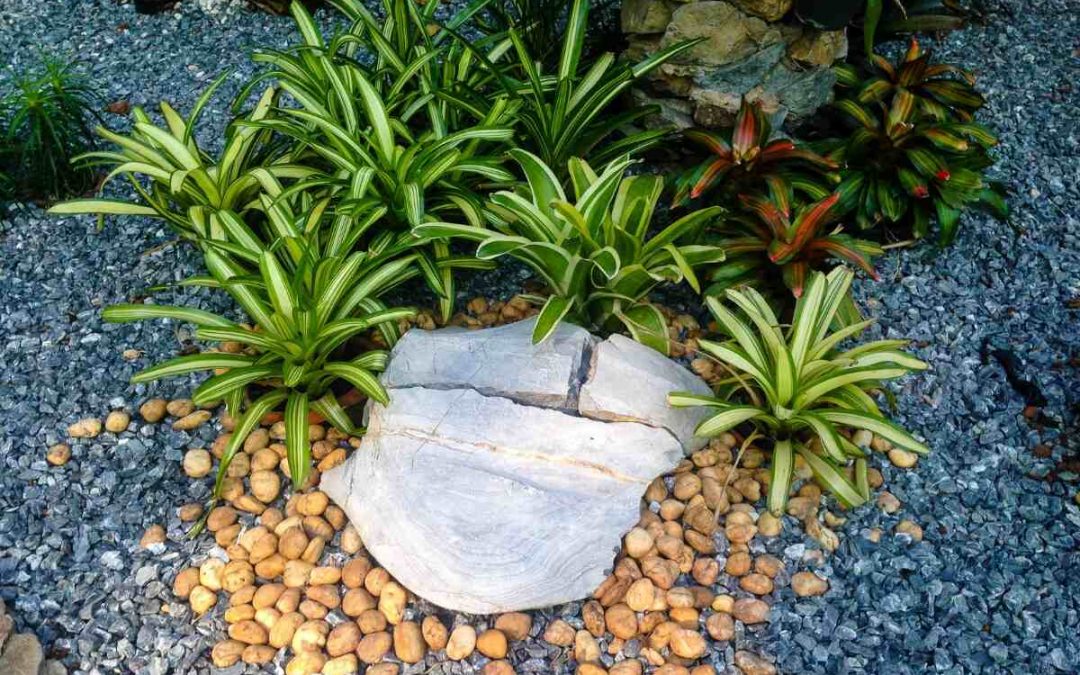Drought is inevitable in California. We don’t have to like it, but we do have to live with it. However, you don’t have to watch your yard die (or your water bill climb) every summer. Adapt your yard to better survive hot, dry conditions, and your water bills and yard maintenance will drop off significantly. Consider the following drought-tolerant landscaping ideas for California.
In this article, we’ll cover:
- Use Drought-Tolerant Plants
- Create a Rock Garden
- Lay Down Some Mulch
- Update Your Irrigation Systems and Methods
- Shrink or Replace Your Lawn
- Install Hardscaping
- Convert to Xeriscaping
7 Drought-Resistant Landscaping Ideas for California
Whether you need a simple first step or want to take drastic measures, the following strategies will reduce water usage. You can apply each drought-resistant landscaping tip on its own or in combination with others.
1. Use Drought-Tolerant Plants
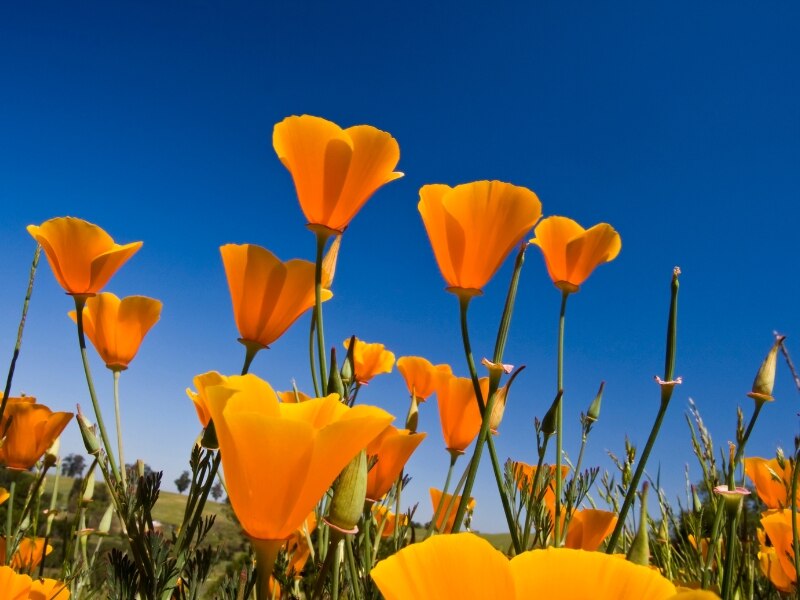
Photo Credit: rhyman007 / Canva Pro / License
While it’s tempting to choose plants solely based on appearance, some plants have higher water needs than others. Focus on garden plants that have low water needs, such as succulents. You can also choose from a variety of other plant types, from trees to ornamental grasses.
California native plants are more likely to be drought-resistant than non-native plants. They also tend to be:
- Eco-friendly
- Wildlife and pollinator-friendly
- Low-maintenance
- Well-adapted to local soil conditions and weather patterns
- Disease and pest-resistant
It’s best to narrow your search by region, county, or city. For example, a plant native to Southern California may not do well in Northern California. Here are some drought-resistant California native plants to get you started:
Northern California
- California buckwheat
- California poppy
- California sagebrush
- Toyon
Central California
- Big berry manzanita
- California buckwheat
- California poppy
- California sagebrush
- Hummingbird sage
- Toyon
Southern California
- Bush sunflower
- California buckwheat
- California sagebrush
- Desert agave
- Hummingbird sage
- Showy penstemon
- Toyon
Keep in mind that newly planted specimens will need more water than established plants. These increased water needs are why perennials are typically better than annuals.
- Annuals have a short lifespan and need to be replanted yearly.
- Perennials can last decades and only need extra water at the beginning of their lifespan.
2. Create a Rock Garden
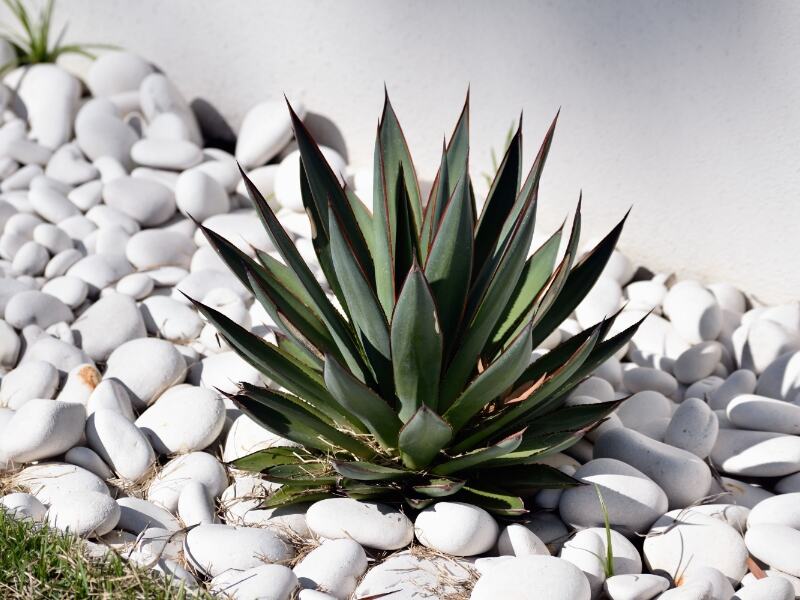
Photo Credit: IKALSEMI / Canva Pro / License
Plants are often the focal point of gardens, but rocks deserve more credit. If you’re not convinced, check out the California Rock Garden at UC Davis or Dave’s Rock Garden in Encinitas. These gardens showcase rocks of various shapes, sizes, and colors alongside native plants.
If you feel inspired, make your own rock garden. Choose neutral-toned or colorful rocks to suit your tastes, and arrange them in whatever patterns your heart desires. Styles can range from desert landscapes to zen gardens. You also can integrate rocks into a small part of your yard rather than the whole thing. Here are some elements you could include:
- Boulders
- Pebbles
- Gravel
- Sand
- Flagstones
- Petrified wood
- Lava rocks
- River rocks
- Bridges
- Paths
- Mosaics
- Statues
- Benches
- Gazebos
Note: While many rock gardens include water features, it’s not a very drought-friendly option. Consider dry ponds or riverbeds instead. You also could use a bird bath to keep visiting wildlife happy and hydrated.
Rock gardens aren’t just an aesthetic choice. The rocks require no water or maintenance. They also suppress weeds and prevent garden plants from growing where you don’t want them to. Of course, you don’t have to forgo vegetation altogether. Some plants, such as chalk dudleya, grow better in rocky environments and require little irrigation to survive.
3. Lay Down Some Mulch
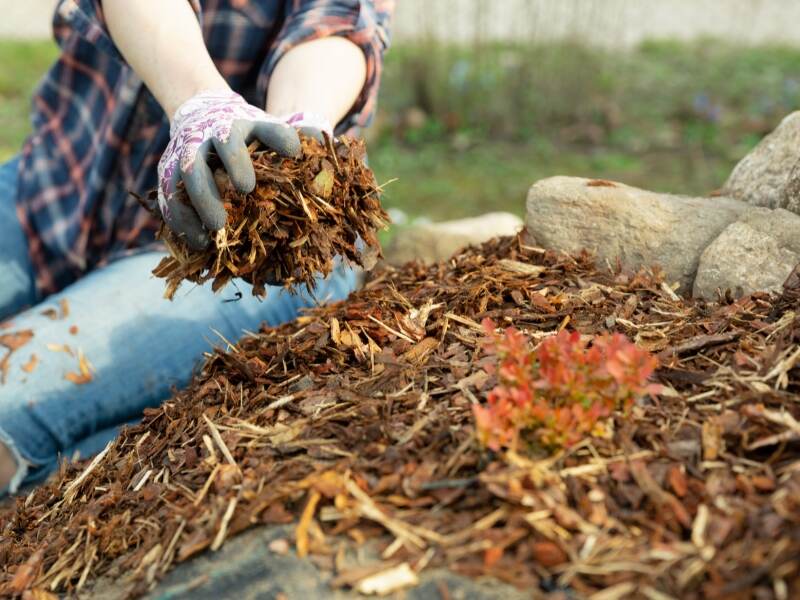
Photo Credit: artursfoto / Canva Pro / License
What is mulch? Mulch is organic or inorganic material spread over the ground, typically around plants. Examples include:
- Bark
- Compost
- Grass clippings
- Gravel
- Leaves
- Pebbles
- Pine needles
- Rubber
- Stones
- Straw
- Wood chips
Mulch plays many roles in landscaping, but how does it help with drought resistance? When applied over the soil, mulch can help retain moisture by preventing evaporation. You also can use it to cover large areas as an alternative to grass or groundcovers. When placed around plants, it will suppress weeds competing for water.
4. Update Your Irrigation Systems and Methods
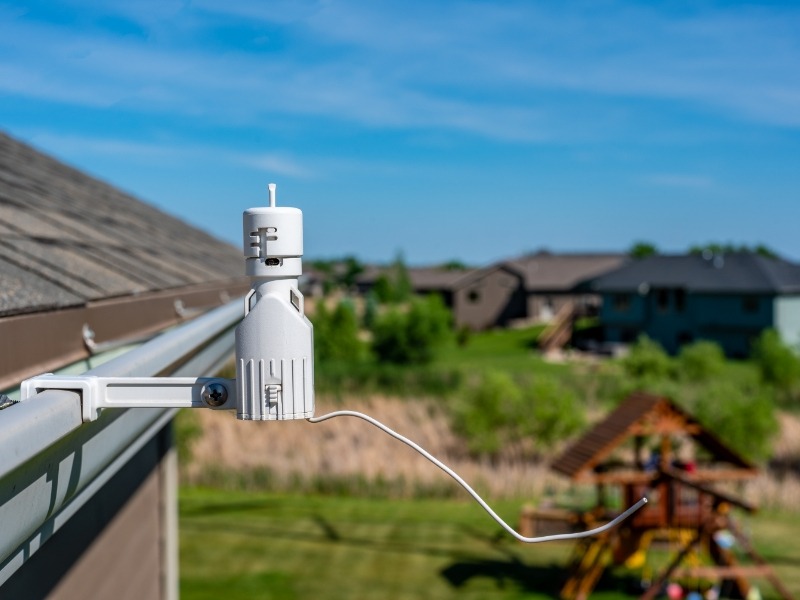
Photo Credit: Steven White’s Images / Canva Pro / License
Whether or not your plants are drought-resistant, you may be overwatering. Many plants need less water than you expect to survive and can go dormant to survive dry conditions. The water also could be going to the wrong place entirely, where it is not accessible to the plants. Here are some steps to take to make sure your irrigation systems are water-wise:
- Water in the morning if possible. Early morning irrigation gives time for the water to soak into the soil without evaporating. While nighttime irrigation may seem just as good, it doesn’t allow plants to dry off naturally in the sun, which could encourage diseases. Water before 8 AM or as early as local restrictions will allow.
- Install rain sensors on automatic sprinklers. Californians joke that it never rains, but what if it does? The blissful forgetfulness automatic sprinklers allow could lead to wastage if you haven’t checked the weather. A rain sensor will do the work for you and turn your sprinklers off when the downpour starts.
- Use soaker hoses or drip irrigation. These irrigation systems deliver water directly to where it needs to go without the risk of runoff.
- Collect rainwater. When nature offers a helping hand, take it. You do not need a permit to collect rainwater from rooftops, and newly constructed rainwater capture systems are excluded from property tax assessments. Water collected from rain barrels is safe to use for outdoor irrigation.
5. Shrink or Replace Your Lawn
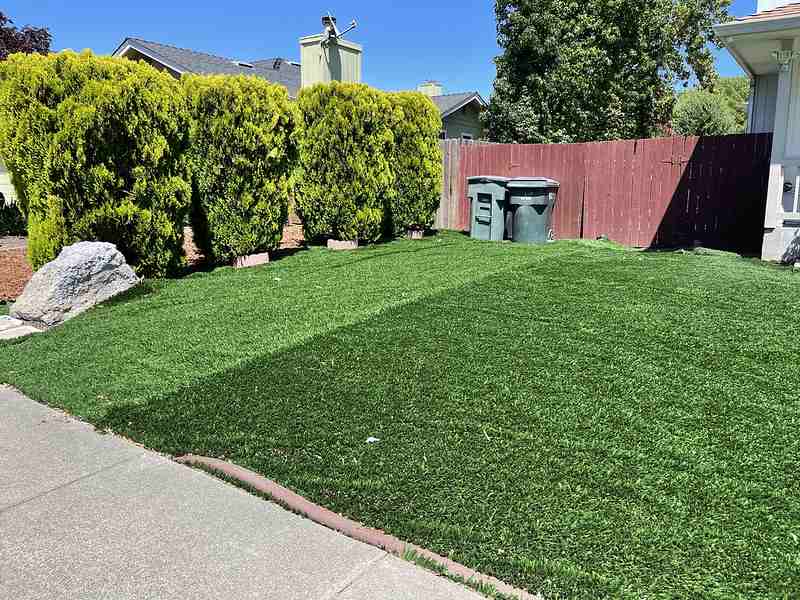
Photo Credit: Sarah Stierch / Flickr / CC BY 2.0
When it comes to drought resistance, lawns have a bad reputation. 40% to 60% of landscape irrigation is used for turfgrass. You don’t necessarily have to give up your lawn entirely, but you should consider what you want out of your lawn and what alternatives could work just as well.
Consider how much lawn you need. Maybe your kids enjoy the backyard lawn, but the front yard lawn doesn’t get much use. You also may want to extend your patio a little further to better host guests. These are perfect opportunities to reduce your turf square footage and save water. Some counties, such as Los Angeles, offer rebates based on how much grass you remove.
If you’re ready to replace your lawn completely, consider these drought-tolerant alternatives:
- Drought-tolerant grass types like California native bentgrass
- Groundcovers such as frog fruit
- Artificial turf*
*Artificial turf is not eligible for lawn removal rebates.
6. Install Hardscaping
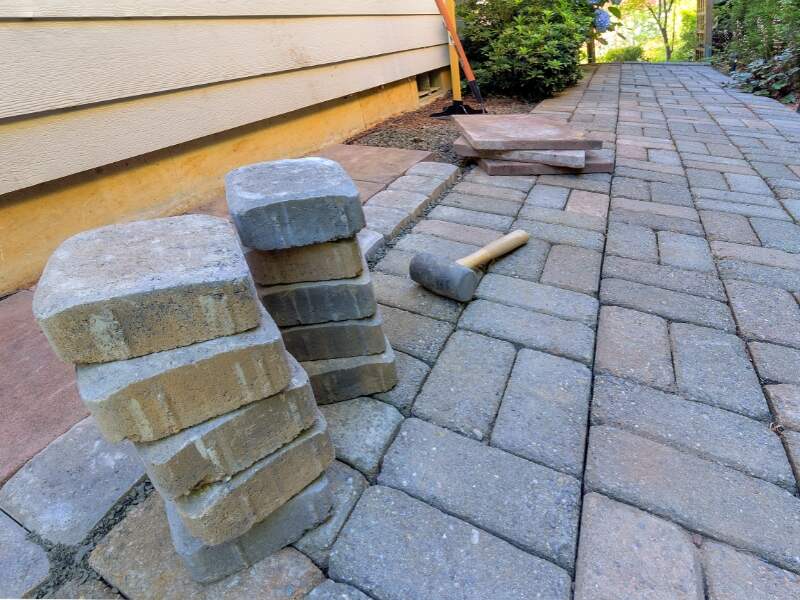
Photo Credit: JPLDesigns / Canva Pro / License
A hardscape is an artificial landscape design that doesn’t use plants. You can create patios, walkways, retaining walls, fire pits, or basketball courts. Here are some possible materials:
- Asphalt
- Bricks
- Cement
- Gravel
- Pavers
- Rocks
- Stones
- Tiles
- Wood
No vegetation means no irrigation. However, permeable surfaces are the most drought-friendly way to go. They reduce runoff and allow water to seep into the soil to be used by nearby plants.
7. Convert to Xeriscaping
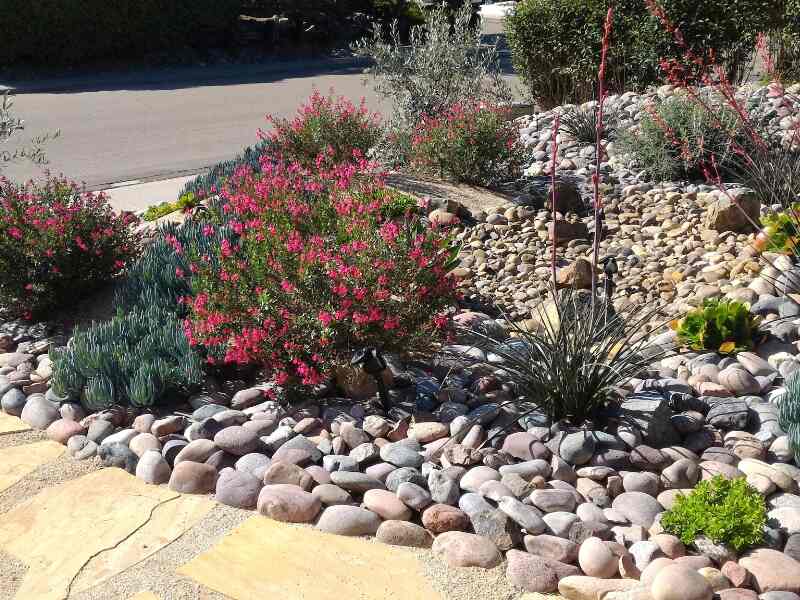
Photo Credit: remedypic / Canva Pro / License
If several of these ideas have piqued your interest, consider a more radical redesign. A xeriscape landscape design requires little to no water or maintenance. Here are the fundamental principles, many of which we’ve covered in this article:
- Xeric plants: This vegetation needs little water to survive California’s desert, arid, or Mediterranean climate. They also typically need less trimming, fertilization, pest control, and disease treatment. You can use native plants or well-adapted plants from other regions.
- Lawn alternatives: Traditional lawns have no place in a xeriscape. Fill open spaces with groundcovers, mulch, or hardscaping.
- Thoughtful irrigation: Use drip irrigation to deliver water exactly where it needs to go with little wastage. You also can hydrozone to make irrigation even more efficient. Hydrozoning is when you group plants with similar water needs together.
While each part of xeriscaping saves water, combining all of them makes this strategy the most effective.
This landscape design is best for homeowners who want to remodel their yards and don’t mind the extra time and cost. It’s also suitable for currently empty yards or newly built homes.
FAQ About Drought-Resistant Landscaping in California
California cities and counties often offer rebates for drought-tolerant landscaping, but you need to meet certain conditions. Possible requirements include:
●Removal of turfgrass (typically around 200 to 500 square feet at minimum)
●Installation of native or drought-tolerant plants
●Use of mulch and rocks
●Permeable hardscaping
●Pool removal
●Irrigation upgrades
●Stormwater retention systems
Check your local county rules for specific requirements and rebate programs. You will likely need to apply for these rebates before you start your project, or you may not be eligible. Artificial turf does not count toward these rebates.
As of 2022, turf replacement rebates are exempt from state income tax.
Often, the answer is yes. Hardscaping, rock gardens, and inorganic mulch (excluding rubber and landscape fabric) close to your home can help reduce the spread of fire. You must still be mindful of flammable materials near your home, such as wooden patio furniture. Choose non-flammable materials whenever possible.
Drought-tolerant plants are also beneficial because they tend to be less dry and flammable. However, no plant is entirely fireproof, and they must be well-hydrated to have the best chance of survival. Keep plants spaced out and far away from your house’s walls so the fire doesn’t have a direct route to your home.
The most drought-friendly grass types in California are:
●Zoysiagrass
●Buffalograss
●Bermudagrass
●Bentgrass
When to Hire a Pro
Some drought-tolerant changes are easy to make. A trip to your local native plant nursery or a DIY drip irrigation kit are projects some homeowners are happy to tackle.
However, large projects can take time and effort. A landscaping professional can simplify drought-resistant landscaping for you. Wikilawn can connect you to local pros in San Diego, Los Angeles, San Francisco, and many other California cities.

